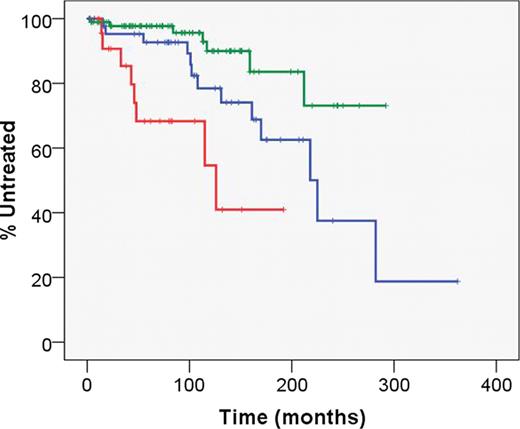Abstract
Abstract 4608
Serum free light chain (sFLC) ratios have prognostic value in many haematological malignancies, including multiple myeloma (Kyrtsonis 2007), Waldenstrom's macroglobulinaemia (Leleu, 2007), solitary plasmacytoma of bone (Dingli et al., 2006) and chronic lymphocytic leukaemia (CLL) (Pratt et al., 2008). Polyclonal sFLC levels predict outcome in chronic kidney disease (Hutchison et al., 2009) and more recently show potential prognostic significance in identifying the risk of lymphoma transformation in HIV patients (Landgren et al., 2010). Using a previously characterised CLL population here we report the prognostic significance of polyclonal sFLC levels in this disease.
167 untreated Stage A (Binet) CLL patients (male: female ratio 1.6:1; mean age 74: range 44–98) were analysed for FLC and β-2M using nephelometric immunoassays (The Binding Site, Birmingham, UK) on the Siemens BN™II analyser. Previously recorded measurements for other biological and clinical markers (age, sex, CD38 (43 pos, 116 neg, 8 unreported), Zap70 (38 pos, 111 neg, 18 unreported), and IGVH mutational status (122 Mutated versus 17 Unmutated, 28 unreported) were used in the statistical analysis which was performed using SPSS v 18.
35 of 167 patients had sFLC>50mg/L and had the following characteristics: Median age 79 (range 62–98), IVGH Mutated v Unmutated (22 v 7; 6 unknown), Zap 70 pos v neg (9 vs 23, 3 unknown), CD38 pos v neg (11 vs 23, 1 unknown), and b-2M >3.5mg/L (23 v 12).Analysis of this population identified summated polyclonal sFLC >50mg/L as being significantly associated with progressive disease and worse outcome. 18/35 patients have progressed to treatment and 10/35 patients have died. Median time to first treatment was 83 months in the sFLC >50mg/L group compared to 170 months for patients with sFLC <50mg/L, (p=0.031). Median survival points were not reached but 75%ile survival was significantly shortened in patients with sFLC >50mg/L compared to those with a lower sFLC concentration (98 vs 201 months p=0.006). A 3 tiered risk stratification model (n=93, n=46, n=23) based upon FLC>50mg/L and b-2M >3.5mg/L identified a group of patients exhibiting significantly shorter time to first treatment (Fig. 1 p=5×10-5).
Despite the heterogeneous clinical course of CLL the universal factor characterising the disease course is abnormal B-cell proliferation. Here we have demonstrated that subtle elevations in polyclonal FLC (>50mg/L) are associated with poorer clinical outcomes and may identify an aggressive sub-population in Stage A CLL patients. Furthermore, a risk stratification model utilising elevated polyclonal FLC and elevated b-2M may help long term clinical management decisions through prompt indication of worse prognosis and shorter survival time.
Kaplan Meier survival curves for 167 Stage A CLL patients. Summated FLC >50mg/L were combined with ß-2M >3.5mg/L to produce a three tiered risk stratification model. Patients with 0 (ß-2M <3.5mg/L + FLC <50mg/L, green, 75% untreated =212 months), 1 (ß-2M >3.5mg/L or FLC >50mg/L blue, 75% untreated = 131 months),or 2 (ß-2M >3.5mg/L and FLC >50mg/L red, 75% untreated = 46 months) risk factors had significantly overall survival times (p=5*10-5)
Kaplan Meier survival curves for 167 Stage A CLL patients. Summated FLC >50mg/L were combined with ß-2M >3.5mg/L to produce a three tiered risk stratification model. Patients with 0 (ß-2M <3.5mg/L + FLC <50mg/L, green, 75% untreated =212 months), 1 (ß-2M >3.5mg/L or FLC >50mg/L blue, 75% untreated = 131 months),or 2 (ß-2M >3.5mg/L and FLC >50mg/L red, 75% untreated = 46 months) risk factors had significantly overall survival times (p=5*10-5)
Levoguer:Binding Site Group Ltd: Employment. Faint:Binding Site Group Ltd: Employment. Harding:Binding Site Group Ltd: Employment.
Author notes
Asterisk with author names denotes non-ASH members.


This feature is available to Subscribers Only
Sign In or Create an Account Close Modal